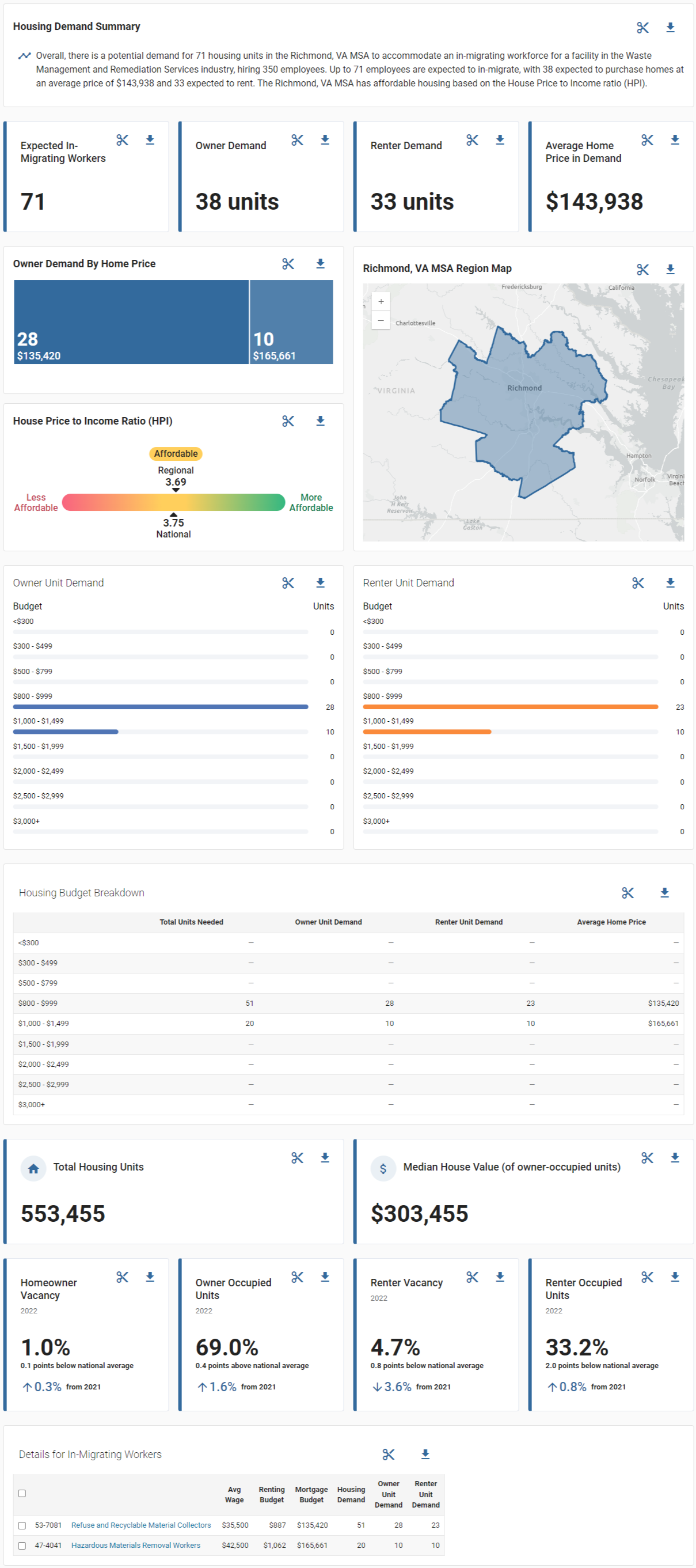JobsEQ has long been able to assist economic developers position their communities as attractive locations for new and expanding businesses with tools like What-If and LaborEQ, which offer insights into expected payroll, cost of living, and detailed labor availability of a proposed location.
But an oft overlooked and difficult question to answer is will those workers have somewhere to live? We explore this issue in our webinar Housing as a Vehicle of Economic Development.
To address this critical piece of any site selection or economic development opportunity, Chmura is excited to introduce the Housing Demand Analytic within the JobsEQ platform.
Meeting the challenge of housing demand forecasting
The Housing Demand Analytic was designed to meet the increasing relevance of housing demand questions in site selection and business expansion considerations. Developed in conjunction with Chmura’s consulting team to provide local officials with reliable projections to determine how many new workers might relocate to the area and even what types of housing they would require.
The new Housing Demand Analytic allows you to quickly assess how much labor can be sourced from a proposed location and how much will have to migrate in based on the industry and the proposed location’s available workforce. From here, the analytic forecasts the unique housing need created by the influx of new workers.
How the Housing Demand Analytic Works

This analytic takes users through a series of customizable features to pinpoint housing demand based on specific factors:
Custom Regions
Define housing demand within a specific drive time or distance around the proposed business location. This function is perfect for understanding housing needs for both city centers and surrounding rural areas, adapting to local housing contexts.
Local vs. Relocating Labor Assessment
The analytic assesses how much of the workforce can be sourced from the local area versus how much might need to move in. For communities and developers, this insight is essential to gauge what percentage of demand may come from new residents needing housing.
Detailed Housing Breakdown
The Housing Demand Analytic breaks down demand by housing type (renters vs. buyers) and aligns it with expected earnings, enabling users to see the distribution of housing costs that workers may require. This is especially valuable for planning affordable and workforce housing.
Quarterly Data Updates
To ensure accuracy, the analytic integrates with traditional Labor Market Information (LMI) and economic factors (such as interest rates) and updates quarterly, offering users fresh insights to match evolving economic conditions.
The Housing Demand Analytic In Action
The Housing Demand Analytic offers a straightforward interface for exploring housing demand forecasts.
Each piece allows users to adjust key variables, like drive time regions, and displays a breakdown of housing needs by type and affordability, enabling users to visualize how demand will vary based on industry-specific data and projected job numbers.
Key Benefits of the Housing Demand Analytic
- Strategic Community Planning: Economic developers and local officials can use these insights to proactively plan housing resources, ensuring communities can accommodate new workers and minimize housing shortages.
- Enhanced Site Selection: For site selectors, the Housing Demand Analytic provides crucial data to present to clients, supporting the case for ideal business locations by showing how housing infrastructure can meet anticipated needs.
- Informed Decision-Making: By offering detailed, industry-specific insights into housing demand, communities and businesses alike can make smarter, more data-driven decisions that benefit both the local workforce and housing market.
The Housing Demand Analytic represents a step forward for communities aiming to attract business investments while ensuring they’re prepared for growth. With clear insights into housing demand tied to business expansion, Chmura’s latest JobsEQ tool empowers economic developers and site selectors to make informed, strategic choices for the future.
As we look forward to seeing how communities benefit from the Housing Demand Analytic, we invite you to learn more about how this tool can support your community’s growth goals. Schedule a demo or talk to a consultant today.